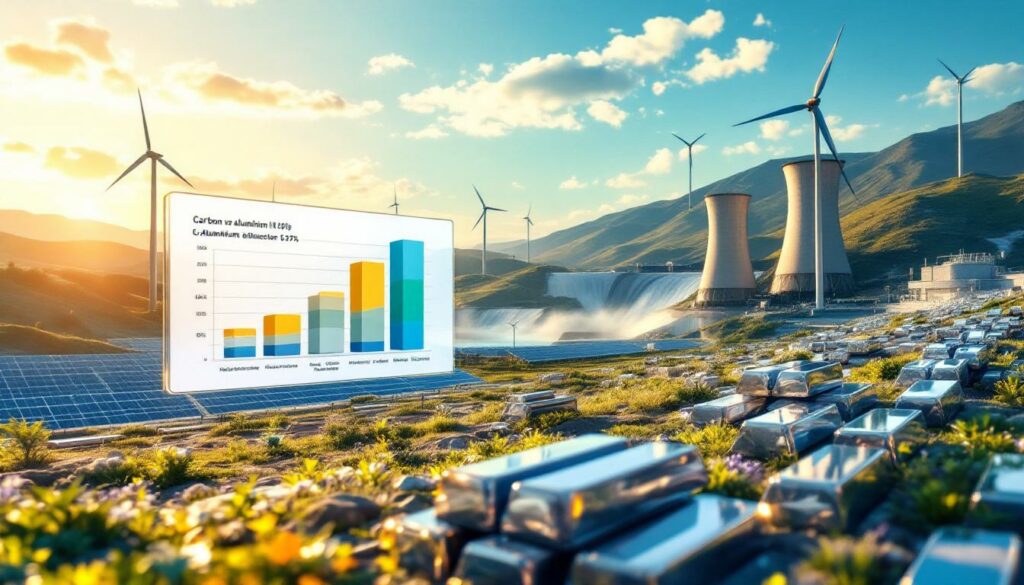Integrated Low-Carbon Aluminium Project in India: A Sustainable Future
The Integrated Low-Carbon Aluminium Project represents a groundbreaking partnership aimed at transforming India's position in the global green metals market. Through innovative renewable energy solutions and state-of-the-art production facilities, this initiative promises to reshape sustainable manufacturing practices while supporting India's industrial growth and climate objectives.
What is the Integrated Low-Carbon Aluminium Project in India?
The Integrated Low-Carbon Aluminium Project is a pioneering joint venture between Rio Tinto and AMG Metals & Materials (AMG M&M), formalized through a memorandum of understanding signed in April 2025. This visionary partnership aims to establish India's most advanced sustainable aluminium production ecosystem, powered entirely by renewable energy sources.
At its core, the project integrates primary aluminium smelting with alumina refining capabilities, creating a comprehensive value chain supported by innovative energy solutions. What distinguishes this initiative is its ambitious scale and commitment to environmental sustainability from the outset.
Key Project Components
- Primary aluminium smelter with potential capacity of 1 million tonnes annually, representing one of India's largest single-site aluminium production facilities
- Alumina production facility with 2 million tonnes annual capacity, ensuring vertical integration and supply chain security
- Renewable energy infrastructure combining wind, solar, and pumped hydrostorage technologies for reliable, carbon-minimal operations
- Phased development approach beginning with 500,000 tonnes/year capacity to optimize implementation and verify performance metrics
The project's feasibility assessment is currently underway, focusing initially on the 500,000-tonne first phase of the aluminium smelter. This staged approach allows for optimization of both production processes and renewable energy integration before scaling to full capacity.
Why is This Project Significant for India's Industrial Landscape?
India's manufacturing sector has been pursuing twin objectives: accelerating industrial growth while simultaneously reducing environmental impact. The integrated low-carbon aluminium project addresses both priorities by introducing domestic production capacity that significantly reduces carbon emissions compared to conventional aluminium manufacturing.
This initiative comes at a critical juncture in India's industrial development. With aluminium demand projected to grow at 8-10% annually through 2030, driven by infrastructure, automotive, aerospace and renewable energy sectors, domestic production capacity enhancement is essential for economic self-reliance.
Strategic Importance
- Industrial sovereignty: Positions India as a leader in low-carbon aluminium production, reducing dependency on carbon-intensive imports from countries with coal-dominated energy grids
- Technological leapfrogging: Bypasses carbon-intensive development phases by implementing cutting-edge renewable integration from inception
- Export potential: Creates opportunities for India to supply premium low-carbon aluminium to global markets with increasingly stringent environmental requirements
- Sectoral transformation: Establishes a blueprint for electrification in mining across multiple industries
By demonstrating that heavy industry can operate successfully with renewable energy, the project challenges conventional assumptions about the necessary carbon intensity of materials production. This paradigm shift could accelerate similar transformations across India's industrial landscape.
How Will Renewable Energy Power This Massive Industrial Project?
Aluminium production ranks among the most energy-intensive industrial processes globally, with electricity typically accounting for 30-40% of production costs. The project's innovative energy approach tackles this challenge through a sophisticated multi-source renewable strategy.
The cornerstone of the energy solution lies in the complementary integration of variable renewable sources with advanced energy storage capabilities. This hybrid approach ensures the consistent, high-quality power supply essential for aluminium smelting operations.
Renewable Energy Integration Strategy
- Solar Power: Utility-scale photovoltaic installations will leverage India's exceptional solar resources, with potential for 2,000+ hours of generation annually in optimal regions
- Wind Energy: Strategically placed wind farms will complement solar generation, with particular value during monsoon seasons when solar irradiance decreases
- Pumped Hydrostorage: This critical component provides essential energy storage capacity, enabling the project to balance intermittent renewable generation against the smelter's constant power requirements
- Integrated Power Management: Advanced digital systems will optimize energy dispatch across production facilities, maximizing renewable energy solutions while maintaining production stability
The pumped hydrostorage component represents a particularly innovative solution for industrial applications. By using excess renewable generation to pump water to elevated reservoirs during peak production periods, the system can release this stored energy through hydroelectric turbines when renewable generation decreases.
Comparative Advantage in Carbon Reduction
| Traditional Aluminium Production | Integrated Low-Carbon Project |
|---|---|
| 12-16 tonnes CO₂ per tonne of aluminium | Estimated 4-6 tonnes CO₂ per tonne |
| Coal-powered electricity (70-80% of global production) | Renewable energy powered |
| Limited energy storage capabilities | Pumped hydrostorage for reliability |
| Higher operational costs due to carbon pricing | Lower exposure to carbon pricing mechanisms |
| Vulnerable to fossil fuel price volatility | Stable long-term energy costs |
This integrated approach addresses the fundamental challenge that has historically limited renewable energy adoption in aluminium production: the need for uninterrupted, high-volume power. By solving this through storage integration, the project demonstrates a replicable model for decarbonizing energy-intensive industries worldwide.
What Makes This Project Unique in the Global Aluminium Industry?
The global aluminium sector faces mounting pressure to reduce environmental impacts while meeting growing demand. This project introduces several innovations that distinguish it from conventional aluminium production facilities and position it at the forefront of industry evolution trends.
Most existing "low-carbon" aluminium production relies primarily on legacy hydroelectric resources rather than new renewable development. Additionally, few facilities integrate both alumina refining and aluminium smelting with comprehensive renewable power solutions. This project's holistic approach represents a step-change in sustainability ambition.
Industry-Leading Features
- Unprecedented renewable integration scale: The project will deploy one of the world's largest dedicated renewable energy systems for primary aluminium production
- Comprehensive value chain approach: By covering both alumina and aluminium production, the initiative addresses emissions across multiple production stages
- Strategic market positioning: Location in India combines advantages of a high-growth domestic market with export access to Asia-Pacific regions
- Technological innovation partnership: Collaboration between Rio Tinto's metallurgical expertise and AMG M&M's energy transition specialization enables cross-sector innovation
The project also distinguishes itself through its "designed-for-renewables" approach, rather than retrofitting existing production facilities. This enables optimization of production processes specifically for variable renewable power availability, including potential modifications to pot management protocols and production scheduling.
What Are the Potential Economic Impacts of the Project?
While specific financial projections remain confidential during the feasibility assessment phase, projects of this scale typically generate substantial economic benefits across multiple dimensions. The comprehensive nature of this initiative suggests particularly significant impacts for India's manufacturing ecosystem.
Expected Economic Benefits
- Direct employment creation: At full capacity, similar aluminium facilities typically employ 1,000-1,500 skilled workers in operations, with 3,000-5,000 positions during peak construction
- Indirect job multiplication: Industry standards suggest 4-5 indirect jobs created for each direct position through supply chain development and services
- Skills development acceleration: Advanced manufacturing and renewable energy integration require specialized capabilities, creating opportunities for workforce upskilling
- Export revenue generation: Premium pricing for low-carbon aluminium could enhance India's trade balance by $1-2 billion annually at full production
- Tax base expansion: Comprehensive manufacturing facilities typically contribute significantly to both local and national government revenues
Beyond these quantifiable impacts, the project could catalyze development of downstream industries in India, including advanced aluminium fabrication, automotive components, and renewable energy infrastructure manufacturing. This "clustering effect" often magnifies economic benefits beyond the core project itself.
Disclaimer: Economic projections are estimates based on industry standards. Actual outcomes will depend on final project specifications, market conditions, and implementation effectiveness.
How Does This Project Fit Into Global Decarbonization Trends?
The aluminium industry globally accounts for approximately 2% of all human-caused greenhouse gas emissions—a footprint larger than many individual countries. This project represents a significant step toward addressing this environmental challenge while aligning with emerging market requirements for lower-carbon materials.
The timing of this initiative coincides with accelerating global pressure for industrial decarbonization, as evidenced by the EU's Carbon Border Adjustment Mechanism, customer demands for lower-carbon materials, and investor scrutiny of carbon-intensive operations.
Alignment with Global Sustainability Initiatives
- Paris Agreement compatibility: The project's carbon reduction approach supports the emissions trajectories needed to limit global warming to 1.5°C
- Market-driven transformation: Responds to growing premium pricing for low-carbon materials from automotive, electronics, and construction sectors
- Industrial proof-of-concept: Demonstrates viable pathways for electrification and decarbonisation in energy-intensive manufacturing
- Certification readiness: Positions production for compliance with emerging standards like the Aluminium Stewardship Initiative (ASI)
- Replication potential: Establishes technical and business model precedents applicable to other regions and industrial sectors
As global markets increasingly differentiate products based on embedded carbon, the project's timing provides India with a first-mover advantage in positioning its industrial capacity for a carbon-constrained future. This market evolution is already evident in price premiums of 5-15% for certified low-carbon aluminium in European and North American markets.
What Challenges Must Be Overcome for Successful Implementation?
Despite its promising outlook, the project faces several significant hurdles that must be addressed during the feasibility assessment phase. Recognizing and systematically mitigating these challenges will be crucial for successful implementation.
Key Implementation Challenges
- Renewable Energy Infrastructure: Developing sufficient renewable capacity (estimated 3-4 GW) to power energy-intensive smelting operations requires unprecedented scale coordination
- Technical Integration: Synchronizing alumina production with smelting operations while accommodating variable renewable generation presents complex operational challenges
- Regulatory Navigation: Securing necessary permits across energy, environmental, and industrial domains requires coordination across multiple government agencies
- Financial Viability: Ensuring competitive production costs despite higher initial capital investment compared to conventional facilities
- Water Management: Addressing substantial water requirements for both production processes and pumped hydrostorage facilities, particularly in regions with seasonal water variability
The feasibility assessment must also address India-specific challenges, including land acquisition processes, grid interconnection protocols, and alignment with state-level industrial policies. These contextual factors can significantly impact implementation timelines and costs.
For the pumped hydrostorage component specifically, geological and topographical requirements must be balanced with proximity to production facilities and transmission infrastructure. This multi-variable optimization represents one of the project's most complex technical challenges.
What is the Development Timeline and Investment Outlook?
While detailed capital expenditure figures remain confidential pending feasibility study completion, comparable projects globally suggest investment requirements of $3-5 billion for the integrated facilities at full capacity. The project's phased approach provides insights into how development might proceed over the coming decade.
Phased Development Strategy
- Feasibility Assessment (Current Phase): Comprehensive technical, economic, and environmental evaluation of the integrated concept, likely requiring 12-18 months
- Initial Development: First phase focusing on 500,000 tonnes/year smelter capacity and associated renewable infrastructure, potentially operational by 2028-2029
- Full-Scale Implementation: Expansion to 1 million tonnes/year aluminium and 2 million tonnes/year alumina production, likely completed by 2030-2032
- Renewable Energy Integration: Parallel development of wind, solar, and pumped hydrostorage infrastructure, with capacity additions coordinated with production expansion
The staged approach allows for adaptation to evolving market conditions, technological developments, and regulatory frameworks. It also enables progressive learning and optimization before full-scale deployment, potentially reducing overall project risk.
From an investment perspective, the project represents a significant commitment to India's industrial future. The renewable energy component alone typically accounts for 25-30% of total project costs in comparable initiatives, highlighting the substantial climate-focused investment involved.
Disclaimer: Timeline projections are estimates based on industry standards. Actual development schedules will depend on multiple factors including regulatory approvals, financing arrangements, and construction conditions.
How Does This Project Compare to Other Low-Carbon Aluminium Initiatives?
The global race to develop low-carbon aluminium production has accelerated in recent years, with several notable projects underway. Understanding this competitive landscape provides essential context for evaluating the Integrated Low-Carbon Aluminium Project's potential impact and distinctive features.
Comparative Analysis of Major Low-Carbon Aluminium Projects
| Project | Location | Capacity (tonnes/year) | Energy Source | Status | Distinctive Features |
|---|---|---|---|---|---|
| ELYSIS | Canada | Technology provider | Hydropower | Commercial demonstration | Inert anode technology eliminating direct carbon emissions |
| Aluminium Stewardship Initiative | Global | Certification standard | Various | Operational | Sets standards for responsible production across value chain |
| Rio Tinto-AMG M&M India Project | India | Up to 1 million | Wind, solar, hydrostorage | Feasibility stage | Integrated production with hybrid renewable solution |
| RUSAL Low-Carbon Aluminium | Russia | Multiple facilities | Hydropower | Operational | Leverages existing hydroelectric infrastructure |
| Alcoa Sustainable Solutions | Global | Various | Mixed renewable | Various stages | Focus on bauxite residue remediation alongside carbon reduction |
| Emirates Global Aluminium | UAE | 2.6 million | Natural gas, increasing solar | Operational | Solar park integration with existing facilities |
This comparative analysis reveals the Integrated Low-Carbon Aluminium Project's distinctive approach. While some initiatives focus primarily on technology innovation (ELYSIS) or certification (ASI), and others leverage existing hydropower resources (RUSAL), the India project combines new renewable development with integrated production facilities in a high-growth market.
The project's approach to renewable integration with storage capability also distinguishes it from competitors that rely on grid interconnection or focus solely on production process improvements without addressing energy sourcing comprehensively.
What Are the Implications for India's Climate Commitments?
India has established ambitious climate goals, including achieving net-zero emissions by 2070 and reducing carbon intensity of its economy by 45% by 2030 compared to 2005 levels. Industrial decarbonization represents one of the most challenging aspects of this transition, making projects like this particularly significant for national climate strategy.
Contribution to National Climate Objectives
- Industrial emissions reduction: Demonstrates pathways to lower carbon intensity in hard-to-abate sectors, potentially avoiding 1-1.5 million tonnes of CO₂ annually compared to conventional production
- Renewable capacity expansion: Drives substantial new renewable energy development, contributing to India's 500 GW non-fossil electricity capacity target for 2030
- Green manufacturing leadership: Establishes India as an innovation center for climate-aligned industrial production
- Technology localization: Creates opportunities for domestic manufacturing of renewable components and specialized equipment
- Policy development catalyst: Provides real-world case study for effective industrial decarbonization policy frameworks
The project also addresses the critical challenge of "embedded carbon" in manufactured goods—an increasingly important factor in international trade as steel & aluminum tariffs impact global markets. By reducing the carbon intensity of aluminium production, India can maintain market access while meeting climate commitments.
For India's broader climate strategy, the project demonstrates that economic development and emissions reduction can be pursued simultaneously through strategic investment and innovation. This "leapfrog" approach could inform decarbonization strategies across multiple industrial sectors.
FAQs About the Integrated Low-Carbon Aluminium Project
Who are the key partners in this project?
Rio Tinto, a multinational mining company with extensive experience in aluminium production, and AMG Metals & Materials (AMG M&M), a specialist in energy transition solutions, are the primary partners who signed the memorandum of understanding in April 2025. This partnership combines Rio Tinto's metallurgical expertise with AMG M&M's capabilities in developing innovative energy solutions for industrial applications.
What makes aluminium production carbon-intensive?
Traditional aluminium production requires enormous amounts of electricity for the electrolysis process that separates aluminium from alumina, typically consuming 13,000-15,000 kWh per tonne of aluminium produced. When this electricity comes from fossil fuels, particularly coal, it results in significant carbon emissions. Additionally, the smelting process itself produces direct emissions through the consumption of carbon anodes, which are oxidized during electrolysis, releasing CO₂.
How does renewable energy integration reduce the carbon footprint?
By powering the aluminium production process with renewable energy instead of fossil fuels, the project eliminates most of the indirect emissions associated with electricity generation, which typically account for 60-70% of aluminium's carbon footprint. The pumped hydrostorage component ensures reliable power supply despite the intermittent nature of wind and solar resources, maintaining production stability while maximizing renewable utilization.
What is the significance of including alumina production in the project?
Integrating alumina production (the intermediate step between bauxite mining and aluminium smelting) creates a more complete value chain within the project. This vertical integration reduces transportation emissions and provides more comprehensive control over the environmental footprint of the entire production process. It also enables optimization of energy and resource flows between production stages, potentially improving
Ready to Stay Ahead of Major Mineral Discoveries?
Discover significant ASX mineral findings the moment they happen with Discovery Alert's proprietary Discovery IQ model, delivering instant notifications to help you make informed investment decisions before the broader market. Explore historic returns of major mineral discoveries at Discovery Alert's discoveries page and begin your 30-day free trial today.




